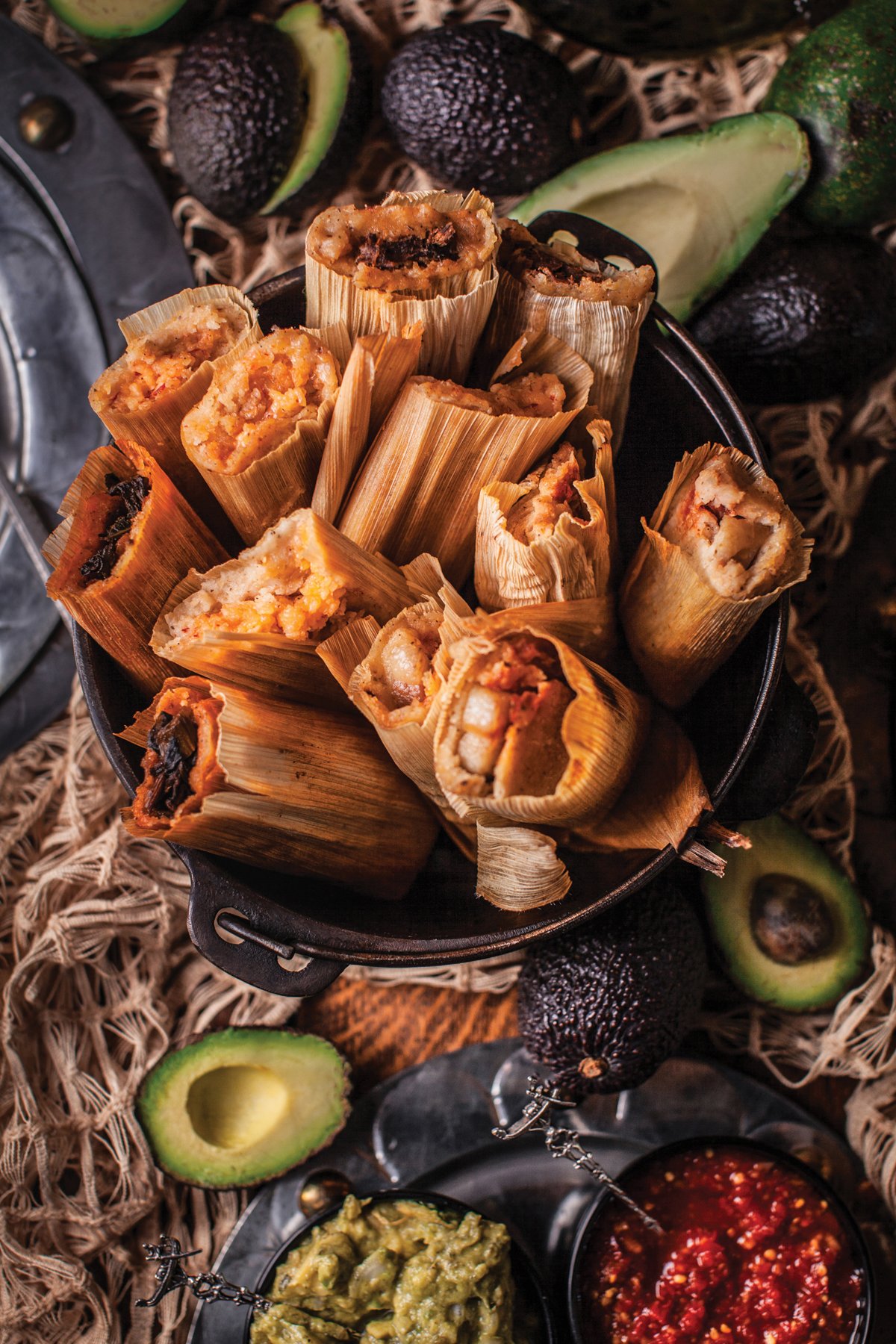
In True Winter Fashion, Tamales Are Back.
A go-to menu item for many people, tamales can also unlock a treasure trove of cherished memories — ones of making them with loved ones , or cooking up a big batch to take to work and share with co-workers.


Sweet corn also happens to be Mary’s favorite. “One of my best memories is of me and my dad going to the plaza in my hometown, buying sweet corn tamales and a cup of hot chocolate, and enjoying the view.” That was the first tamale Mary learned to make since it was her father’s favorite; “it helps me remember him now that he’s gone.”
Tamales are a touchstone to history as well. As Gustavo Arellano notes in his engaging Taco USA: How Mexican Food Conquered America, nixtamalized cornmeal wrapped in corn husks dates way back to the Aztecs in the 1300s. Their process of treating the corn is still used to this day, and involves soaking the dried kernels in an alkaline solution — usually lime or wood ash. The process not only makes the kernels easier to grind, but also enhances the corn’s vitamin B3, which can help prevent the life-threatening disease known as pellagra.
Subsequent eras brought various twists to the tamale concept, and to the region’s cuisine in general. In the 1500s, the conquering Spaniards introduced lard to many dishes, while Franciscans brought beef to the table in the late 18th century.
Luckily for us, this cuisine drifted northward, and even Good Housekeeping printed its first tamale recipe in 1894. Along with chili, “tamales represented Mexican food to most Americans for nearly 60 years, from their mass introduction during the 1890s through the end of World War II,” wrote Gustavo.
Though knowledge of Mexican food has obviously expanded since the last century, tamales still hold a special place in the culture, perhaps because there’s much more to making a tamale than the process. It’s about sharing the knowledge, labor, and — perhaps most importantly — time spent with family and friends.
“When my parents retired in Mexico, my mom created a ‘tamale club’ with the local women,” reminisces Martha. “They would make tamales to sell and raise funds for the church. I’d help when I was visiting. It was really a great excuse to eat fresh tamales with a glass of beer and be happy. The stories they’d share were filled with local history, folklore and gossip. It was so fun.”
And for Mary, tamales were made for “being prepared and eaten at many holidays and family gatherings. Behind each tamale there is hard teamwork and time, but you like doing it because the best part is when you put them on the table and everyone enjoys them.”
She advises that if making tamales at home, pay at least as much attention to the masa as to the filling and“know the amount of time you’re going to cook them for so you use the right amount of lard to keep the tamale from drying out.”
Martha admits that she was spoiled by her former mother-in-law’s meticulous masa method. “She would start with prepared masa, add bits of lard into it as she beat it with her fist then test it in a glass of water to see if it would float. If it did not, I would take over the beating and keep at it until it did. Now I judge all tamales by the masa. Some are too dry, too thick, and have very little filling.”
And while you may think you’re doing your guests a favor by taking off the husks, Martha always serves her tamales still wrapped. “I find the unwrapping of a tamale is like unwrapping a gift. It builds the anticipation of the goodness inside.”


For some unique tamales around the county, try these:
Mary’s Cuisine Catering Services in San Luis Obispo won both categories at Atascadero’s 2020 Tamale Festival. The traditional tamale winner was pork with red salsa and pico de gallo, and the gourmet entry was steak with onion, bell peppers and cheese. (805) 260-6042
Alyx Gille of Good Tides Organic Bistro is the first to admit her small batch tamales are “California fusion, definitely not traditional,” but they’ve proven quite popular with patrons at the Monday Baywood Park and Saturday San Luis Obispo farmers’ markets. Though a few of her tamales have lard, most are made with a vegetarian-friendly, soy-free shortening. All the masa is non-GMO/organic corn and seasoned with salt-free dehydrated vegetables. (805) 234-4177
For another take on tamales, check out the Tamalito Negro on the Para Picar menu at the Peruvian-influenced Mistura. Peruvian tamales are typically wrapped in banana leaves, use white corn instead of yellow, and have more items in the filling, such as aji pepper sauce, achiote and chicken broth. Chef Nicola Allegretta puts a gourmet riff on his shrimp-filled Tamalito Negro by using squid ink topped with a creamy bisque. 570 Higuera St. in San Luis Obispo. misturarestaurants.com. (805) 439-3292
We recommend these restaurants that offer various traditional tamales, on their menus and by special pre-order:
Garcia’s
9550 El Camino Real in Atascadero
(805) 460-6580
Las Delicias de Zacatecas
12304 Los Osos Valley Road in San Luis Obispo
(805) 439-2361
San Miguel Bakery
1912 Creston Road, Ste. B in Paso Robles
(805) 226-9453
And don’t forget to check the tamale booths at your local farmers’ markets.

